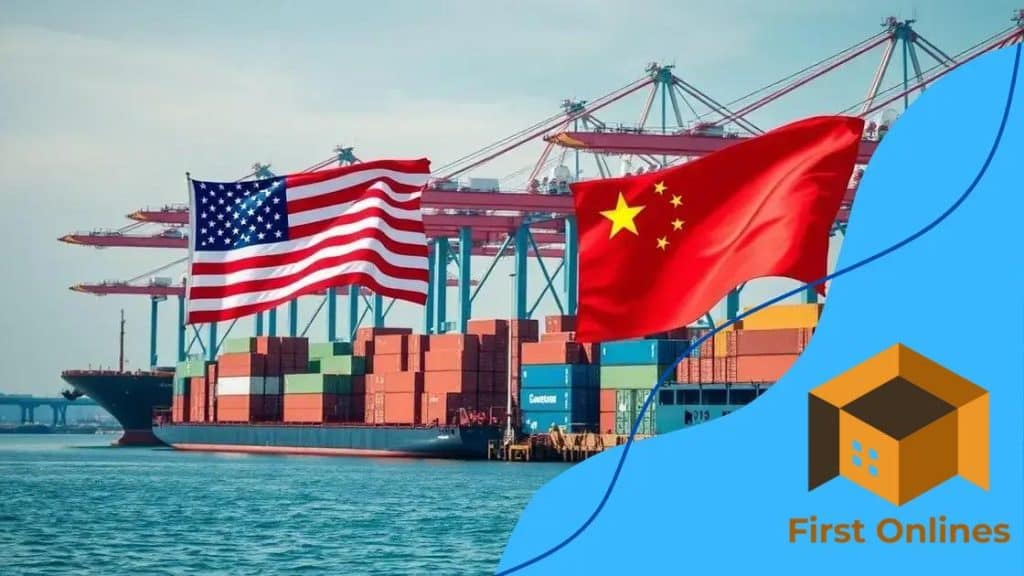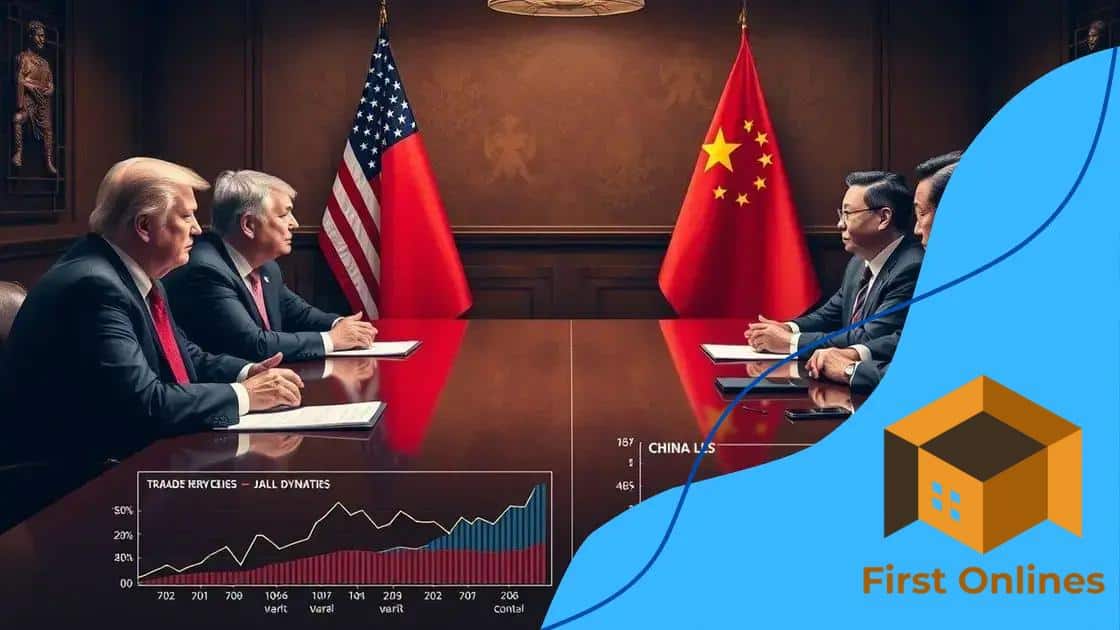How the US-China trade relations are affecting global economies

Anúncios
How the US-China trade relations affect global economies is evident as they influence tariffs, supply chains, and economic strategies, driving businesses to adapt to changes for competitiveness in a shifting marketplace.
How the US-China trade relations are affecting global economies is a fascinating topic that many are discussing today. As these two nations navigate complex trade agreements and tariffs, it’s essential to understand the rippling effects on global markets. Ever wondered how your daily life could be influenced by these relations?
Anúncios
Background of US-China trade relations
The background of US-China trade relations is complex and steeped in history. Over the past few decades, these two powerhouse economies have forged a relationship that has fluctuated between cooperation and competition. Understanding their trade history can provide insights into current events.
Historical Context
Initially, the US and China established trade ties in the late 20th century. With China’s admission to the World Trade Organization (WTO) in 2001, the trade between the two countries significantly expanded. This period witnessed a surge in imports and exports, transforming their economic landscapes.
However, as China’s economy grew, concerns over trade imbalances also emerged. The US has often criticized China for its trade practices, including currency manipulation and restrictions on foreign companies. These tensions have led to a series of negotiations and modifications in trade policies.
Anúncios
Key Developments in Recent Years
- In 2018, the US imposed tariffs on billions in Chinese goods, marking the beginning of a trade war.
- In response, China also imposed tariffs on American products, disrupting many industries.
- Efforts for a trade deal resulted in the Phase One Agreement in January 2020, but challenges remain.
As the global economy continues to evolve, the relationship between the US and China will affect not only their nations but also economies worldwide. Changes in trade policies can lead to shifts in supply chains, influencing prices and consumer behavior across various sectors. The impact of these decisions is felt globally, whether in the prices of goods at the store or the availability of products.
Key economic effects on global markets
The key economic effects on global markets due to US-China trade relations are profound and extensive. As these two nations engage in trade, their decisions significantly impact economies around the world. From markets to consumers, changes reverberate through different sectors.
Impact on Global Supply Chains
Global supply chains have been dramatically affected due to trade policies. Many companies source parts and materials from multiple countries. When tariffs and trade restrictions are implemented, this can lead to increased costs and production delays. Businesses must adjust, often raising prices for consumers.
- Increased costs of raw materials can lead to higher product prices.
- Companies may seek alternative suppliers to reduce reliance on affected regions.
- Supply chain disruptions can cause delays in product availability.
As companies scramble to adapt to these changes, the economic landscape continues to shift. For instance, businesses might relocate manufacturing to avoid tariffs, which affects local jobs.
Effects on Currency Value
The value of currencies can also fluctuate because of trade relations. When trade tensions escalate, investors may seek safety in stable currencies. This shift can devalue others, making global trade even more complicated. A weaker currency can increase export competitiveness but make imports more expensive.
This dynamic creates a challenging environment for businesses operating across borders. Investors and companies must navigate these unpredictable markets carefully.
The ripple effects can be felt not only in stock prices but also in everyday items consumers buy. When companies face higher costs, they often pass those on, impacting the average consumer.
The role of tariffs and trade agreements

The role of tariffs and trade agreements is crucial in shaping the relationship between the US and China. Tariffs are taxes imposed on imported goods, and they directly affect prices and trade flows. By adding tariffs, countries seek to protect their own industries while penalizing foreign competitors.
How Tariffs Impact Trade
When tariffs are imposed, the cost of importing goods increases. This often leads to higher prices for consumers. For instance, if the US places tariffs on Chinese electronics, American consumers may pay more for gadgets. As a result, it can also encourage local production.
- Tariffs can lead to reduced imports as consumers seek cheaper alternatives.
- Domestic producers may experience a boost in sales due to less foreign competition.
- Increased prices for imported goods can strain household budgets.
The effects go beyond local markets; they ripple through global supply chains. Suppliers and manufacturers must adapt to changing costs, influencing their production choices and strategies.
Trade Agreements and Their Significance
Trade agreements serve as the framework for how countries interact economically. The Phase One Deal between the US and China aimed to ease tensions by setting terms for trade. These agreements often include commitments on tariffs and intellectual property. They help outline clear rules for businesses, promoting stability.
By engaging in trade agreements, countries can lower tariffs, increasing the flow of goods and services. For example, when tariffs are reduced, consumers benefit from lower prices and greater variety. This can lead to a positive cycle of economic growth and job creation. However, when agreements are broken or modified, it can lead to uncertainties that affect markets.
Analyzing shifts in supply chains
Analyzing shifts in supply chains is essential to understanding how global trade dynamics are changing, especially between the US and China. As tariffs and trade policies evolve, companies must adapt their supply chain strategies to remain competitive.
Why Shifts Occur
Shifts in supply chains happen for various reasons. Companies may look to reduce costs or mitigate risks associated with political tensions. For instance, the US-China trade war prompted many businesses to reconsider their reliance on Chinese manufacturing. This is especially true for technology firms that feared tariffs on imports.
- Companies seek alternative suppliers to avoid high tariffs.
- Manufacturing relocation to countries with lower costs can enhance profit margins.
- Technological advancements allow for more flexible supply chain management.
In response to these shifts, some companies have diversified their supply chains by sourcing materials from different regions. This not only minimizes risk but also helps stabilize production flow amid uncertainties.
Effects on Industry
Shifts in supply chains can significantly affect various industries. For example, the electronics industry has seen manufacturers relocating to countries like Vietnam and India. This change can lead to shorter lead times and better access to emerging markets.
Moreover, as businesses adapt, consumers may experience changes in product availability and pricing. If companies have to reroute their supply chains, it might take time before pricing stabilizes. During this transition, consumers could face higher costs or limited options.
The Future of Supply Chains
Looking ahead, flexibility will be the key to successful supply chain management. Companies that invest in new technologies and develop relationships with multiple suppliers will likely thrive. Understanding and adapting to shifts in supply chains allows businesses to stay resilient in an ever-evolving global market.
Future predictions for global economies
Future predictions for global economies hinge on various factors, especially the ongoing dynamics of US-China relations. As these two dominant economies navigate their challenges, the effects will ripple across the globe, influencing markets, trade, and investments.
Impact of Ongoing Trade Relations
As tariffs and trade agreements evolve, global economies will respond in different ways. Some countries may seize opportunities to become alternative suppliers, while others may struggle to keep pace. It’s important to note that the interconnectedness of economies means that decisions made in Washington or Beijing can have unforeseen consequences.
- Increased investments in technology sectors may lead to growth in digital economies.
- Emerging markets could experience accelerated growth by filling gaps left by traditional powers.
- Shifts in supply chains may stabilize economies that adapt quickly to new conditions.
Countries that are more flexible and willing to innovate will likely emerge stronger. For instance, nations that invest in green technologies may find themselves leading the charge as demand for sustainable solutions rises.
Potential Economic Shifts
One potential shift is a move toward regional trade agreements. As global trade becomes more uncertain, countries may prioritize closer ties with neighboring nations over distant partners. This strategy could promote greater economic stability and allow countries to support one another during disruptions.
This new focus may also encourage the growth of local industries. By fostering domestic production, countries can reduce their reliance on imports. Economies that can balance both local and international trade will find more resilience in the face of global challenges.
Long-Term Outlook
In the long term, global economies may transform significantly. Automation and advanced technologies will play a crucial role in shaping industries. As companies adapt to these changes, labor markets may experience disruptions but also new opportunities. Workforce education and training will be vital to ensure that workers gain skills relevant to emerging job markets.
Ultimately, the trajectory of global economies will depend on collaboration, innovation, and adaptability. As nations learn from each other and adjust to new realities, the global landscape will continue to evolve.
\n
\n
\n
FAQ – Understanding the Impact of US-China Trade Relations on Global Economies
How do US-China trade relations affect global economies?
The trade relations between the US and China influence global markets, impacting trade flows, tariffs, and economic strategies of other countries.
What role do tariffs play in international trade?
Tariffs are taxes on imports that can raise prices for consumers and protect domestic industries from foreign competition.
How can countries adapt to shifts in supply chains?
Countries can adapt by diversifying their suppliers, investing in new technologies, and fostering regional trade agreements.
What are the future predictions for global economies?
Future predictions suggest that flexibility, technology investments, and collaboration among nations will be crucial for navigating economic challenges.





